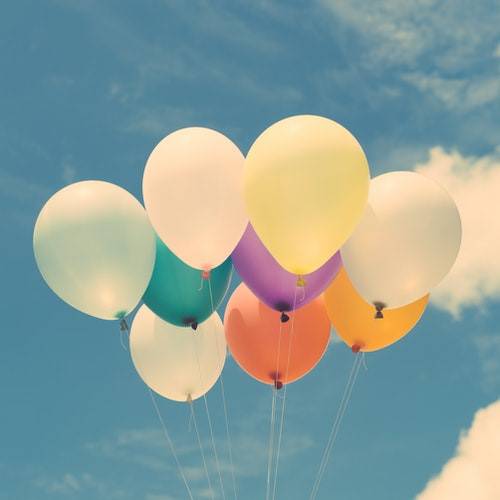
Written by Philippa Walsh
The benefits of breathing techniques
Colour breathing is one of many simple breathing techniques that can be used to reduce stress, improve our oxygen intake and manage anxiety.
You think that breathing would come to us naturally right? And it does… but it only takes a little anxiety, which can produce a lot of adrenaline, to throw our breathing off balance.
Often when we are stressed or anxious, our breathing can become shallow. The correct way of breathing is to breathe from the diaphragm rather than the upper chest, and to take breaths in through the nose and out through the mouth.
Maybe the thought of that impending meeting with your manager is filling you with dread, or perhaps something has happened that is causing you to worry too much and become anxious.
Whatever it is, we can all benefit from learning how to use our breath and our capacity to visualise images for the benefit of our mental well-being.
Why use colour to relax?
The psychology of colour is a widely researched area, and it is believed that certain colours are associated with specific moods and emotions. When we picture certain colours it is believed that we can significantly improve the way we feel.
Colour guide
RED promotes: Energy, strength, motivation, confidence, will-power, courage, initiative, focusing on attention to detail. Good for: Depression, negativity, and shyness (avoid in anger, irritability).
ORANGE stimulates: Body and mind, self-esteem, optimism, inner strength, creativity, self-expression, happiness, opens mind to new ideas and perspectives. Good for: Depression, negativity, trauma, stress, bereavement and loss.
GOLD promotes: Enthusiasm, balancing thoughts and feelings. Good for: wisdom depression (especially during menopause), stress and anxiety.
YELLOW is: Uplifting, cleansing, associated with self-respect, self-confidence, self-control, ability to rationalise and reason, and is mentally stimulating. Good for: depression, despair, fatigue, negativity, sensitivity to criticism, lack of confidence (avoid in insomnia, hyperactivity).
GREEN promotes: Balance, harmony, personal development, self-acceptance, compassion for self and others and renewal. Good for: Stress, anxiety, self-pity and confusion.
TURQUOISE promotes: Calm, cleansing, healing, personal relationships, sharing, friendship. Good for: resilience to stress, anxiety and anger.
BLUE promotes: calm, peace, relaxation, slowing down, steadying, self-expression, intuition, honesty, truth and creativity. Good for: insomnia, stress, anxiety, over excitement and anger.
INDIGO promotes: wisdom, intuition, understanding, spirituality, peace, calm, and inspiration. Good for: anger, obsessions, psychoses, insomnia and anxiety (avoid in depression and loneliness).
VIOLET PURPLE promotes: Inspiration, imagination, empathy, sense of belonging, helping others, self-respect and dignity. Good for: Stress, anxiety, obsessions, lack of confidence, low self-esteem and severe depression.
MAGENTA Promotes: letting go of the past or anxiety provoking thoughts, moving on, spiritual understanding. Good for: reducing aggression.
PINK Promotes: calm, clarity of thought, affection, compassion, nurturing, and kindness. Good for: resolving difficult relationships, insomnia, anger, aggression and over-sensitivity.
Colour Breathing Exercise
- Choose the colour of the emotion or state of mind you’d like to feel (even if you don’t feel this way right now).
- Get yourself in a relaxing position, whether sitting comfortably or lying down.
- Close your eyes, and focus only on your breathing.
- Breathe in deeply through your nose for 2 to 3 seconds, hold for a second and release breathing out through your mouth for 3 to 4 seconds.
- Perhaps imagine that you have a small balloon in your stomach and notice how the balloon inflates as you breathe in, and deflates as you breathe out. Notice the sensations of your stomach as it rises when the balloon inflates on the in breath, and falls as the balloon deflates on the out breath.
- Anytime that other thoughts or images come to mind, just notice them and let them go by bringing your attention back to your breathing and your chosen colour.
- Now visualise your colour, perhaps as a light, or a mist right in front of you.
- If you're struggling to visualise that colour, try to picture something representing it, for instance green grass, or blue sea or sky, orange sunset, pink dawn.
- See it in front of you, over you, surrounding you, enveloping you – becoming part of you.
- As you slowly breathe, breathe your colour, into your nose, your throat, your chest and abdomen. Imagine now that colour spreading out within you, into every part of your body, and notice the effects that it has.
- Notice the sensations in your body, as this coloured light or mist, flows into and spreads throughout your body and mind. Perhaps it feels warm and comforting or fresh and invigorating.
- Notice how the colour is affecting your body, and your mind, as you allow it to gently flow and infuse your body and mind. Continue to notice the colour and the sensations that it brings.
- Anytime that your attention wanders, simply notice that it’s wandered, then gently bring your focus back to your colour and your steady relaxed breathing.
- Once you feel in a better state of mind and are ready to return to the present, start to bring your attention back to where you are. Open your eyes and look around, noticing what you see and what you hear. Take a couple of breaths and notice the pleasing sensations that this relaxing coloured breathing has enable you to feel.
Tip: Remember that learning to use a relaxed breathing technique takes practice. Try this daily until it becomes a natural habit for you to use in times of stress.
To learn more about counselling and psychotherapy in Manchester and how relaxation techniques can help with anxiety, reach out to me today
References
The colour guide has been adapted from ‘Colour Your Life’ (come-alive.co.uk).
The exercise has been adapted from the self-help work of Carol Vivyan (2010).
